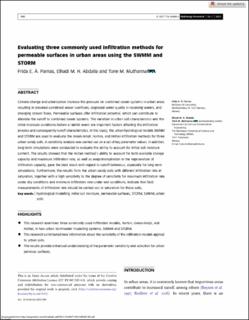| dc.contributor.author | Parnas, Frida Elisif Ågotnes | |
| dc.contributor.author | Hassan Abdalla, Elhadi Mohsen | |
| dc.contributor.author | Muthanna, Tone Merete | |
| dc.date.accessioned | 2022-12-05T09:25:22Z | |
| dc.date.available | 2022-12-05T09:25:22Z | |
| dc.date.created | 2021-01-19T12:21:16Z | |
| dc.date.issued | 2021 | |
| dc.identifier.citation | Hydrology Research. 2021, 52 (1), 160-175. | en_US |
| dc.identifier.issn | 1998-9563 | |
| dc.identifier.uri | https://hdl.handle.net/11250/3035794 | |
| dc.description.abstract | Climate change and urbanization increase the pressure on combined sewer systems in urban areas resulting in elevated combined sewer overflows, degraded water quality in receiving waters, and changing stream flows. Permeable surfaces offer infiltration potential, which can contribute to alleviate the runoff to combined sewer systems. The variation in urban soil characteristics and the initial moisture conditions before a rainfall event are important factors affecting the infiltration process and consequently runoff characteristics. In this study, the urban hydrological models SWMM and STORM are used to evaluate the Green-Ampt, Horton, and Holtan infiltration methods for three urban sandy soils. A sensitivity analysis was carried out on a set of key parameter values. In addition, long-term simulations were conducted to evaluate the ability to account for initial soil moisture content. The results showed that the Holtan method's ability to account for both available storage capacity and maximum infiltration rate, as well as evapotranspiration in the regeneration of infiltration capacity, gave the best result with regard to runoff behaviour, especially for long-term simulations. Furthermore, the results from the urban sandy soils with different infiltration rate at saturation, together with a high sensitivity to the degree of sensitivity for maximum infiltration rate under dry conditions and minimum infiltration rate under wet conditions, indicate that field measurements of infiltration rate should be carried out at saturation for these soils. | en_US |
| dc.language.iso | eng | en_US |
| dc.publisher | IWA Publishing | en_US |
| dc.rights | Attribution-NonCommercial-NoDerivatives 4.0 Internasjonal | * |
| dc.rights.uri | http://creativecommons.org/licenses/by-nc-nd/4.0/deed.no | * |
| dc.title | Evaluating three commonly used infiltration methods for permeable surfaces in urban areas using the SWMM and STORM | en_US |
| dc.title.alternative | Evaluating three commonly used infiltration methods for permeable surfaces in urban areas using the SWMM and STORM | en_US |
| dc.type | Peer reviewed | en_US |
| dc.type | Journal article | en_US |
| dc.description.version | publishedVersion | en_US |
| dc.source.pagenumber | 160-175 | en_US |
| dc.source.volume | 52 | en_US |
| dc.source.journal | Hydrology Research | en_US |
| dc.source.issue | 1 | en_US |
| dc.identifier.doi | 10.2166/NH.2021.048 | |
| dc.identifier.cristin | 1874240 | |
| cristin.ispublished | true | |
| cristin.fulltext | original | |
| cristin.qualitycode | 1 | |

